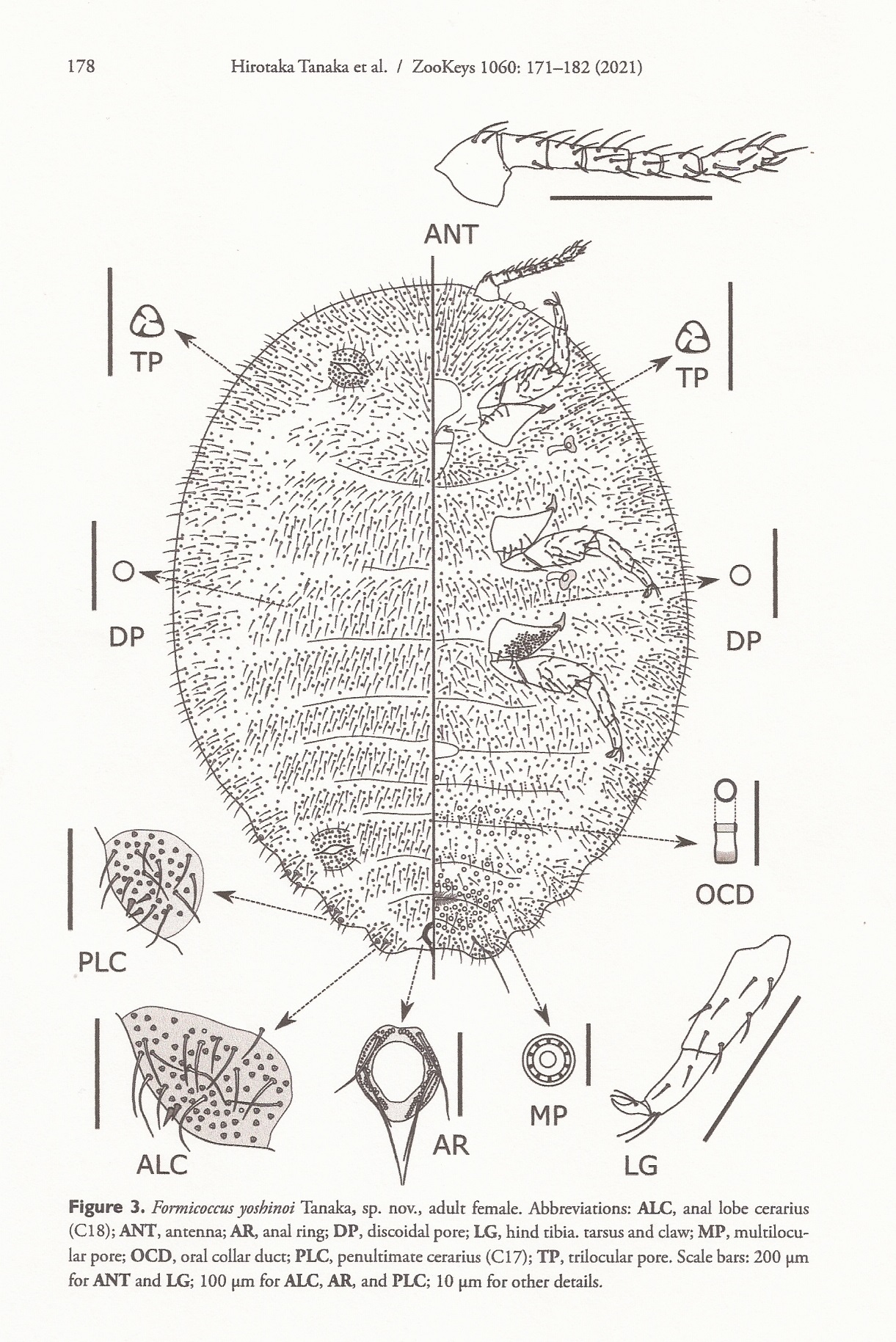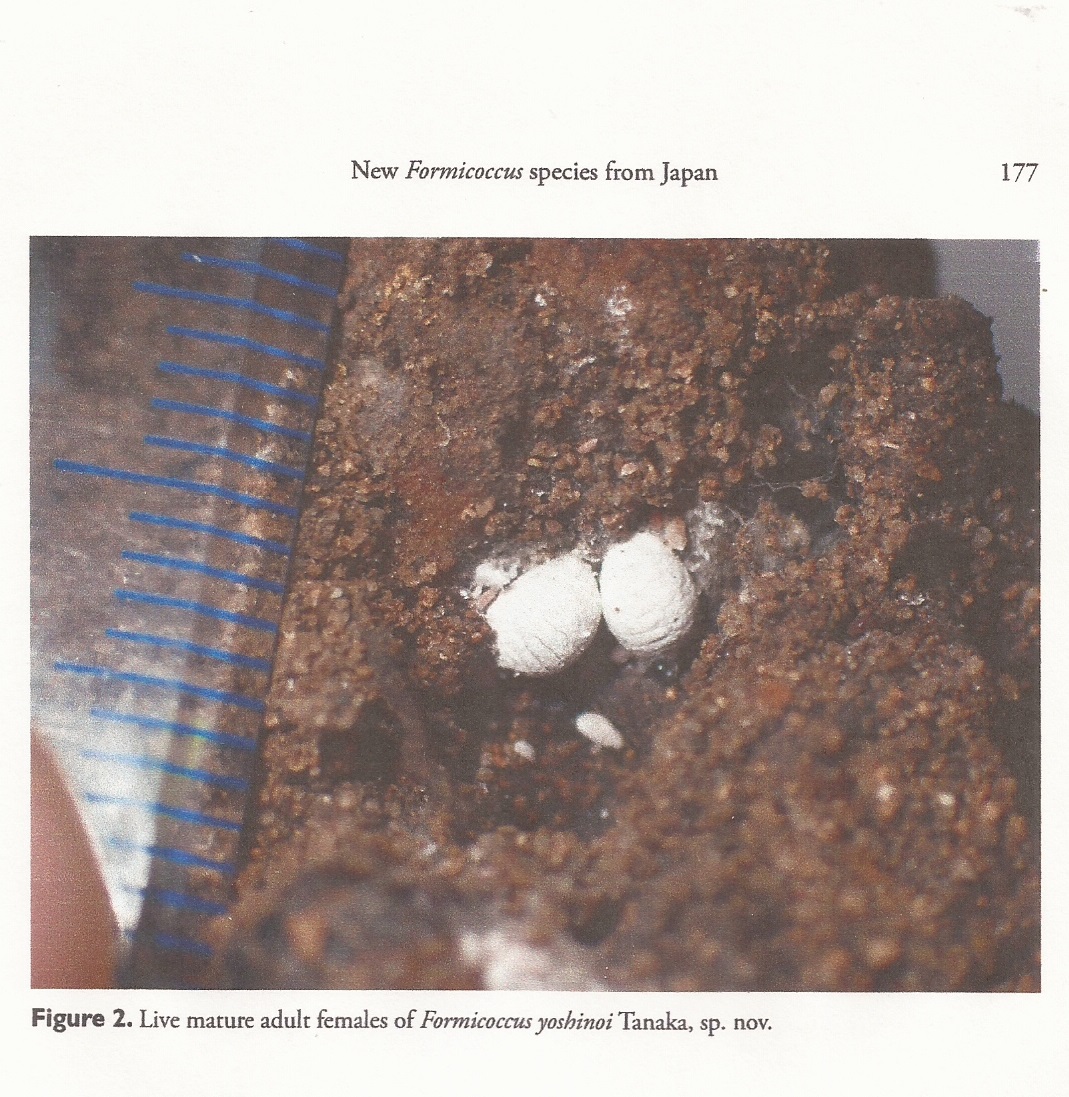Valid Names Results
Formicococcus yoshinoi Tanaka, 2021 (Pseudococcidae: Formicococcus)Nomenclatural History
- Formicococcus yoshinoi Tanaka 2021: 175. Type data: JAPAN: Okinawa Prefecture, Ishigaki Is., Sakieda (24.445794°N, 124.079765°E), on Balanophora fungosa, 12/14/2019, by K. Yoshino. Holotype, female, by original designation Type depository: Fukuoka: Entomological Laboratory, Faculty of Agriculture, Kyushu University, Fukuoka, Japan; Matsuyama: Ehime University Museum, Matsuyama, Japan; accepted valid name Notes: Paratypes: 2 adult ♀♀, same data as for holotype, mounted singly (1 EUMJ, 1 ELKU). 4 adult ♀♀, Japan / Okinawa prefecture / Ishigaki Is., Kabira / 24.451620°N / 124.159781°E /on Balanophora / fungosa / 14. xii.2019 / coll. K. Yoshino; mounted singly (2 EUMJ, 2 ELKU) Illustr.
- Formicoccus yoshinoi; Tanaka 2021: 175. misspelling of genus name
Common Names
Ecological Associates
Hosts:
Families: 1 | Genera: 1
- Balanophoraceae
- Balanophora fungosa | TanakaSuKa2021
Geographic Distribution
Countries: 1
- Ryukyu Islands (=Nansei Shoto) | TanakaSuKa2021
Keys
- Tanaka2022: pp.336 ( Adult (F) ) [Formicococcus species in Japan]
- ZhangWu2022: pp.165-166 ( Adult (F) ) [Palaearctic and Oriental Formicococcus species]
- TanakaSuKa2021: pp.173-175 ( Adult (F) ) [Oriental Formicococcus]
- TanakaSuKa2021a: pp.202-204 ( Adult (F) ) [Formicococcus species in the Oriental region]
Remarks
- Systematics: http://zoobank.org/16C9E917-1BDE-45BA-A3B7-0F59D8F631F5
This species is similar to F. formicarius (Newstead, 1900) and F. erythrinae Williams, 2004, but differs from them by having fewer than six cerarii, and only one type of ventral oral collar tubular duct distributed on the medial area of the posterior abdominal segments. (Tanaka, Suetsugu & Kamitani, 2021) It. is similar to F. formicarius in having: (i) long flagellate dorsal setae; (ii) relatively short and stout legs; (iii) only one type of ventral oral collar tubular duct; and (iv) a round body shape, but differs from this species as follows (characters of F. formicarius are given in parentheses): (i) having fewer than six cerarii with 0–6 conical cerarian setae (with 18 pairs of cerarii with long and stout flagellate setae); and (ii) having a transverse row of ventral oral collar tubular ducts on the medial area of posterior abdominal segments (lacking ventral oral collar tubular ducts on medial area of abdominal segments). The species is also similar to F. erythrinae, 2004, in having: (i) long flagellate dorsal setae; (ii) relatively short legs; and (iii) round body shape, but differs from the latter species as follows (characters of F. erythrinae are given in parentheses): (i) having fewer than six cerarii (having 18 cerarii); and (ii) having only one type of ventral oral collar tubular duct (with two types of ventral oral collar tubular ducts). (Tanaka, Suetsugu & Kamitani, 2021) Although the original publication of the specific name was published as Formicoccus yoshinoi, it is deemed to have been published in combination with the original spelling Formicococcus under Article 11.9.3.2 of the International Code of Zoological Nomenclature (International Commission on Zoological Nomenclature 1999)
- Structure: Live adult female feeding on the underground part of host plant and secreting white powdery wax on all body surfaces. Body shape of mature adult female mostly hemispherical in shape Slide-mounted adult female mostly oval. Anal lobes with well-developed and narrow anal lobe bar. Antenna mostly with seven segments and many flagellatesetae. Legs relatively short and stout, but well developed. Hind legs with numerous translucent pores present on both dorsal and ventral surfaces of coxae. Circulus present etween ventral abdominal segments III and IV. Ostioles present. (Tanaka, Suetsugu & Kamitani, 2021)
- Biology: Specimens of Formicococcus yoshinoi were found in aggregations on the tuber of its host.
- General Remarks: Detailed description, photographs and illustration in Tanaka, et al., 2021.
Illustrations
Citations
- TanakaSuKa2021: description, diagnosis, genebank, illustration, key, taxonomy,
- TanakaSuKa2021a: key, taxonomy,
- ZhangWu2022: key, 166




